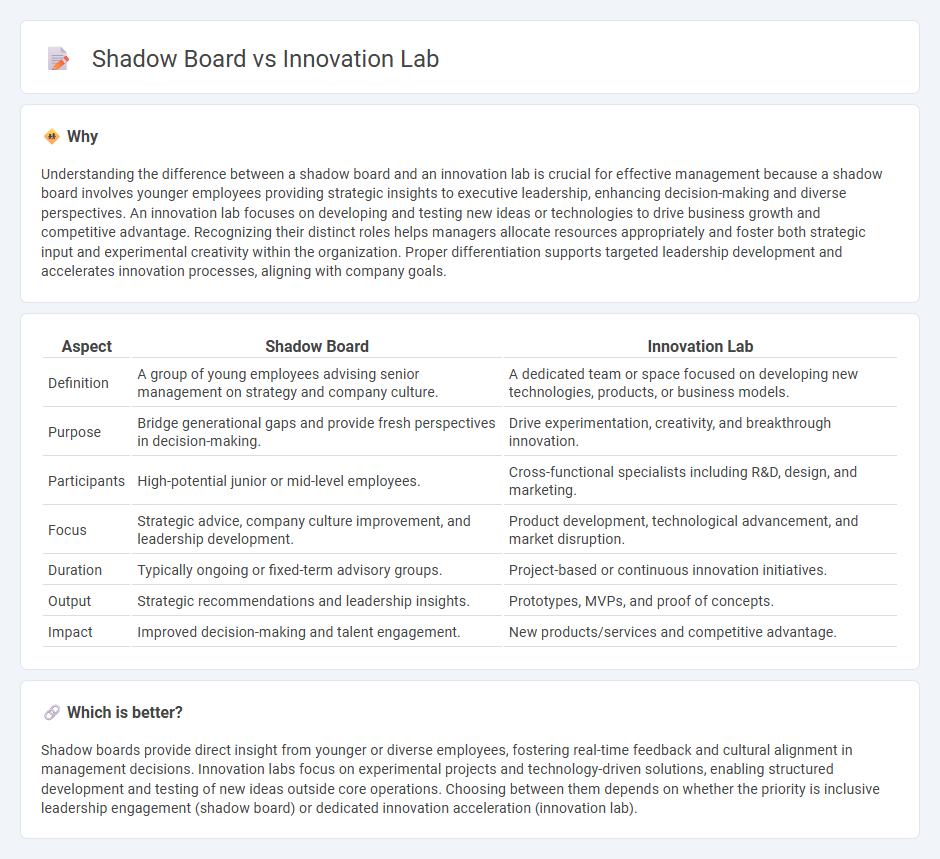
Shadow boards consist of younger employees who provide fresh perspectives directly to senior leadership, fostering diverse input in decision-making processes. Innovation labs function as dedicated spaces where cross-functional teams experiment with emerging technologies and develop groundbreaking solutions to drive organizational growth. Discover how integrating shadow boards and innovation labs can transform your company's management approach.
Why it is important
Understanding the difference between a shadow board and an innovation lab is crucial for effective management because a shadow board involves younger employees providing strategic insights to executive leadership, enhancing decision-making and diverse perspectives. An innovation lab focuses on developing and testing new ideas or technologies to drive business growth and competitive advantage. Recognizing their distinct roles helps managers allocate resources appropriately and foster both strategic input and experimental creativity within the organization. Proper differentiation supports targeted leadership development and accelerates innovation processes, aligning with company goals.
Comparison Table
| Aspect | Shadow Board | Innovation Lab |
|---|---|---|
| Definition | A group of young employees advising senior management on strategy and company culture. | A dedicated team or space focused on developing new technologies, products, or business models. |
| Purpose | Bridge generational gaps and provide fresh perspectives in decision-making. | Drive experimentation, creativity, and breakthrough innovation. |
| Participants | High-potential junior or mid-level employees. | Cross-functional specialists including R&D, design, and marketing. |
| Focus | Strategic advice, company culture improvement, and leadership development. | Product development, technological advancement, and market disruption. |
| Duration | Typically ongoing or fixed-term advisory groups. | Project-based or continuous innovation initiatives. |
| Output | Strategic recommendations and leadership insights. | Prototypes, MVPs, and proof of concepts. |
| Impact | Improved decision-making and talent engagement. | New products/services and competitive advantage. |
Which is better?
Shadow boards provide direct insight from younger or diverse employees, fostering real-time feedback and cultural alignment in management decisions. Innovation labs focus on experimental projects and technology-driven solutions, enabling structured development and testing of new ideas outside core operations. Choosing between them depends on whether the priority is inclusive leadership engagement (shadow board) or dedicated innovation acceleration (innovation lab).
Connection
Shadow boards serve as dynamic platforms where emerging talent collaborates on strategic initiatives, often generating fresh perspectives that feed directly into the innovation lab's experimental projects. Innovation labs harness insights and real-time feedback from shadow board members to accelerate the development of disruptive business models and technologies. This symbiotic relationship enhances organizational agility by combining strategic foresight with rapid prototyping and iterative innovation.
Key Terms
**Innovation Lab:**
An Innovation Lab is a dedicated environment within an organization designed to foster creativity, experimentation, and the development of new products or business models using cutting-edge technologies. It operates with cross-functional teams that leverage agile methodologies and data-driven insights to accelerate innovation cycles and deliver breakthrough solutions. Explore how Innovation Labs drive competitive advantage and transform corporate strategies by learning more.
Experimentation
Innovation labs prioritize structured experimentation and rapid prototyping to develop new products and solutions within organizations. Shadow boards emphasize diverse perspectives by involving younger or non-executive employees in strategic decision-making, fostering innovation through collaborative insight rather than direct experimentation. Explore more to understand how these approaches uniquely accelerate organizational innovation.
Prototyping
An innovation lab specializes in rapid prototyping, allowing cross-functional teams to experiment with new ideas and technologies in a controlled environment. Shadow boards consist of emerging leaders who provide strategic insights but typically engage less in hands-on prototyping activities than innovation labs. Explore how these structures differ in accelerating product development and organizational agility.
Source and External Links
What is an innovation lab? Examples and how to start one - Innovation labs are business units that apply agile startup methods to develop new ideas, often operating independently or within companies to innovate and complement existing business models.
What is an innovation lab? - An innovation lab is a form of open innovation, working with external partners to address corporate challenges through collaboration and experimentation.
The Global Innovation Lab for Climate Finance - This lab identifies, develops, and launches innovative financial solutions to drive investment in climate change action.
 dowidth.com
dowidth.com